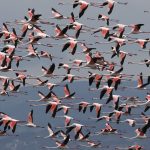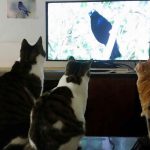Last year 10,000 Birds celebrated Wood Warbler Week, which gave me an opportunity to describe exactly what a Wood Warbler (aka Phylloscopus sibilatrix) really was. And to inform North Americans that their so-called wood warblers would be more aptly named Silly-Canaries. Despite fairly convincing arguments, it seems the entire North American ornithological community has completely ignored all logic and we have yet to see any major changes in naming logic.
Prothonotary Silly-Canary (Protonotaria citrea) at The Biggest Week
This May saw a dramatic change in my life as a birder. One might even go as far as to say it was a turning point – a point to measure and assess my life – before and after The Biggest Week in American Birding.
Crowds on the Magee Marsh boardwalk soaking up all the warbler action. Polite. Excited. Sharing.
My first morning at Magee Marsh and the Biggest Week in American Birding was absolutely incredible. At least as good as all the warblers were the crowds of birders. Everywhere I went there were people loving the birds and hanging out with other birders. And I found the people incredibly polite, friendly and helpful. Now, I really wasn’t expecting that as crowds of people are normally rather pushy and I tend to be a small group or solitary birder – avoiding the crowds and talking. But this was an absolute spectacle.
It would be hard to deny the beauty of the incredible burning Blackburnian Warbler (Setophaga fusca). I believe my first words on seeing a Blackburnian Warbler were: “Holy crap, what the hell is that!” It was that amazing.
The Myrtle Yellow-rumped Warblers (Setophaga coronata coronata) are said to be the most abundant warbler at Magee Marsh in the spring migration, and we certainly did see lots of them. But I never got remotely bored with them.
But my personal favorite of all the wood-warblers I saw during the Biggest Week were the Magnolia Warblers (Setophaga magnolia). Relatively common, beautifully coloured and with wonderful personalities. I also liked their distinctive black and white tails.
On seeing my first Hooded Warbler (Setophaga citrina), I took a few digiscoping snapshots and as I was starting to move off I told someone about it and they almost freaked out: where? where? where? Funny how contextual birds are, I just had no idea that this would be something special there. It was just another of the dozens of incredible warblers about.
The Cape May Warbler (Setophaga tigrina) also seemed to stir up a fair amount of excitement whenever one was about…
… as did the Bay-breasted Warbler (Setophaga castanea).
Black-throated Blue Warblers and Black-throated Green Warblers also came by to check out my digiscoping equipment 😉
Well, the Palm Warbler (Setophaga palmarum) might not have much to compete with a Blackburnian, but I grew to really like them.
The thing that surprised me the most when walking through the boardwalk was the abundance and variety of gaudiness, both in the birds and people. Everywhere I looked, there was a bird even more brightly coloured and interesting. The same went for the people.
 If you have never been to the Biggest Week in American Birding, or Magee Marsh in May then you are seriously missing out. If you have any remote interest in wildlife or nature, then this needs to be put on your bucket list right now. Yup, go ahead and do it. Don’t be coy. Pen. Paper. That easy.
If you have never been to the Biggest Week in American Birding, or Magee Marsh in May then you are seriously missing out. If you have any remote interest in wildlife or nature, then this needs to be put on your bucket list right now. Yup, go ahead and do it. Don’t be coy. Pen. Paper. That easy.
All images digiscoped (c) me with a Swarovski STM80 HD, TLS800 and Canon 7D.

























Yup. Hard-pressed to pick a favorite.
That could have been me and my wife that freaked out over the Hooded Silly-Canary. We did exactly that when someone casually mentioned a Hooded on a relatively unoccupied section of boardwalk. I think we almost knocked down and stomped the poor man to death in excitement, since that bird had been eluding us for years as a “heard-not-seen” on our life list. Always a great time at The Biggest Week.
Darned straight. And in turn I will acknowledge that your bee-eaters, rollers, and hoopoes are pretty darn cool themselves.
@Jason, crazy, crazy, crazy birds
@Kirby, I seemed to have a good deal of luck with Hooded Silly-Canaries, having seen them on a good few occasions on the boardwalk, and got absolutely incredible views of one in Oak Openings.
@Corey, bee-eaters are the bomb – especially Carmine!
Dale ,,
Man great story you must of felt like a kid on Christmas ,, it”s great sharing are neotropic species such as wood Warblers with someone that has experienced the excitement of there first view of these beauty’s.
I never get tired of this time of the year over my time Birding, and late Summer to mid fall when these Warblers and other species make there long trek back to there Wintering grounds can be just as rewarding and challenging on identifying some of them in there drab wear. Kev
Fabulous post, Dale! It was wonderful to meet you and to see your big smile when you stopped in at BSBO to tell me about your time at Magee. I wish Kenn and I could have taken you to dinner or something, but I guess that means you’ll just have to come back next year!
Thanks for helping us spread the joy of this magical place!
~kimberly kaufman
I haven’t been able to get away from work in the spring for years…this really makes me want to do something about that.
Traitor.
So now you’ll agree that wood-warblers should be simply called warblers, and your warblers should be called dull lil babblers.
@David, that is probably the smartest counter I have yet to hear for my Silly-Canary proposal. Being a fan of Linnean naming (the bird that gets the name first gets to keep it), I am going to have to argue that palearctic warblers are going to have to remain warblers. Maybe we need a neutral party to help us out on the decision. I propose Jochen Roeder should have the final say – Jochen, what do you say?
@David & Dale: I’ll respond with a post, here on 10,000 Birds!
There are some wonderful birds up there.
Was a truly awesome experience for me too Dale.. and nice chatting to you on the boardwalk. Before I went, some folks had suggested that I might not enjoy the crowds at Magee but I completely agree with your assessment, everybody was just brilliant.. so friendly and helpful and to be honest made for a even better experience if that was possible and since the action pretty much extended throughout the day till dusk, there were plenty of times when the boardwalk was virtually deserted. Great post. Take care Dale.. will hopefully bump into you again sometime, somewhere.
Not to start a ruckus, but we in Texas do not believe the greatest week in birding occurs in Ohio. April 25, 2021 I had 26 species of warblers within short walking distance in a small Texas Ornithological Society Sanctuary on the Louisiana border called Sabine Woods. I also missed a twenty-seventh species of warbler seen by many others that day. We also had 5 vireo species, 4 thrush species, 2 Oriole spews, 2 tanager species, 2 grosbeaks plus 2 buntings (indigo and painted). Basically a colorful explosion. Every year during north wind fallouts in late April this same phenomenon repeats. We are able to get 20 -27 warblers in one day at this one location at least 4-7 different days each Spring. Anahuac NWR is also relatively nearby (up to 9 rail species possible including yellow and black). I guess we should visit each other’s locations to see how they hold up.